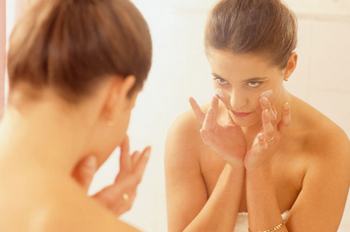What we eat has a profound effect on our outward appearance as well as on our physical well-being. An ideal diet should provide adequate quantities of all the nutrients essential to health and beauty. And don't forget to nourish your mind! The nutrients which are of particular importance for beauty and their main sources are briefly examined here.
| VitaminsVitamin A / Beta Carotene Vitamin B Complex Vitamin C Vitamin D Vitamin E Protein Fats and Oils Water | MineralsCalcium and Phosphorus Chromium Copper Iodine Iron MagnesiumManganese Potassium Selenium Sulfur Zinc |
Vitamin A / Beta Carotene
Vitamin A is essential for healthy hair and eyes. It is also important in the prevention and clearing of infections of the skin. Vitamin A counteracts dry skin, dandruff and wrinkle formation. It is needed for healthy blood circulation which gives a glow to the skin. Vitamin A deficiency can lead to eruptions or dry, coarse, wrinkled skin; dull and dry hair or dandruff; ridging or peeling fingernails; pimples or acne and visual fatigue.
Natural Sources of Vitamin A
- Cod liver oil
- Dairy products
- Eggs
- Carrots
- Green leafy vegetables
- Tomatoes
- Papaya
- Melon
Vitamin B Complex
B vitamins are vital for clear, luminous skin, youthful looks and for delaying greying of hair. They are essential for healthy skin, hair, and eyes. Studies show that 40 percent of dermatitis sufferers lack B vitamins. B vitamins also counteract stress, which has adverse effects on one's appearance.
A deficiency of B complex vitamins can lead to:
Natural sources for Vitamin B Complex
- Whole grain cereals, wheat
- Pulses
- Nuts
- Green leafy vegetables
- Molasses
- Meat
- Liver
- Brewer's yeast
Vitamin C
Vitamin C, in conjunction with protein, is necessary for the production of collagen-the glue that holds us and our skin together and circumvents sags or wrinkles. It regulates sebaceous glands to keep skin from drying out; helps prevent facial lines, wrinkles and spider veins; hair tangling or breaking.
Vitamin C is essential for the health of the hair, eyes and teeth, resistance to infection, healing of wounds and firm skin tissues.
Vitamin C is essential for the health of the hair, eyes and teeth, resistance to infection, healing of wounds and firm skin tissues.
Combined with bioflavinoids, vitamin C
Prevents the pigment clumping that the sun turns into age spots | |
Strengthens capillaries to avoid easy bruising or the tiny hemorrhages that become spider veins. | |
Helps the oil-secreting glands function property to keep the skin from drying out. | |
Prevents bleeding of the gums. |
Natural sources for vitamin C
- Green vegetables, broccoli, cabbage, green peppers, raw leafy greens, tomatoes
- Fresh fruits, like lemon, orange and grapefruit, cantaloupe, kiwi, strawberries
- Potatoes
- Black currants, blackberries, buckwheat, cherries, and grape are rich sources of flavonoids
Vitamin D
Vitamin D is essential for healthy teeth, bones and nails as well as for the assimilation of calcium and phosphorus. It promotes healthy eyes, skin and teeth.
Deficiency of Vitamin D can lead to dental decay.
Natural Sources of Vitamin D
- Rays of the sun
- Milk
- Beef liver
- Salmon
- Tuna
- Butter
- Sprouted seeds
- Synthetic Vitamin D is manufactured from fish liver oils
Vitamin E
Vitamin E helps form muscles and tissues to prevent wrinkles and premature aging of the skin. It helps prevent dry, dull skin, age spots, falling hair and dandruff. It improves circulation and healing of scars. Research has shown that large doses of vitamin E double healthy cell reproduction to slow the aging process and forestall premature wrinkling.
Caution: If you have diabetes, high blood pressure, or an overactive thyroid, check with your physician before taking supplemental E.
Natural Sources of Vitamin E
- Whole wheat bread
- Whole grains
- Wheat germ
- Milk
- Raw or spouted seeds
- Asparagus
- Broccoli
- Brussels sprouts
- Butter
- Egg yolks
- Leafy greens
- Liver
- Olives
- Soybeans
- Sunflower seeds
- Nuts
- Vegetable oils
Master Vitamin And Mineral Formula
Vitamins
Beta Carotene 10,000 I. U. as Vitamin A
Vitamin D 400 I. U.
Vitamin E 200 I. U .
Vitamin K 50 mcg.
Vitamin C 200 mg.
Bioflavonoids 100 mg.
Rutin 25 mg.
Hesperidin 25 mg.
Folic Acid 400 mcg.
Vitamin B1 (Thiamine) 10 mg.
Vitamin B2 (Riboflavin) 10 mg.
Niacin 20 mg.
Niacinamid 20 mg.
Vitamin B6 (pyridoxine) 10 mg.
Vitamin Bl2 (Cobalamine) 30 mcg.
Biotin 150 mcg.
Pantothenic Acid 50 mg.
Choline 50 mg.
Inositol 50 mg.
Para Aminobenzoic Acid (Paba) 30 mg.
Vitamin D 400 I. U.
Vitamin E 200 I. U .
Vitamin K 50 mcg.
Vitamin C 200 mg.
Bioflavonoids 100 mg.
Rutin 25 mg.
Hesperidin 25 mg.
Folic Acid 400 mcg.
Vitamin B1 (Thiamine) 10 mg.
Vitamin B2 (Riboflavin) 10 mg.
Niacin 20 mg.
Niacinamid 20 mg.
Vitamin B6 (pyridoxine) 10 mg.
Vitamin Bl2 (Cobalamine) 30 mcg.
Biotin 150 mcg.
Pantothenic Acid 50 mg.
Choline 50 mg.
Inositol 50 mg.
Para Aminobenzoic Acid (Paba) 30 mg.
Minerals
Calcium 500 mg.
Iodine 150 mcg.
Iron 15 mg.
Magnesium 250 mg.
Copper 2 mg.
Zinc 15 mg.
Manganese 15 mg.
Potassium 50 mg.
Chromium 50 mcg.
Selenium 20 mcg.
Iodine 150 mcg.
Iron 15 mg.
Magnesium 250 mg.
Copper 2 mg.
Zinc 15 mg.
Manganese 15 mg.
Potassium 50 mg.
Chromium 50 mcg.
Selenium 20 mcg.
Digestive Aids
Iron Ox Bile 10 mg.
Bromelain 10 mg.
Pancrelipaze 15 mg.
Papain 10 mg.
Betain HCl 10 mg.
Lecithin 600 mg.
Bromelain 10 mg.
Pancrelipaze 15 mg.
Papain 10 mg.
Betain HCl 10 mg.
Lecithin 600 mg.
How To Take
All vitamins and minerals should be taken as follows:
6 days per week-take continuously; one day-stop taking;
Then 3 weeks per month-take continuously; one week-stop taking;
Then 5 months take continuously; one month-stop taking-and then continue with the food supplements.



